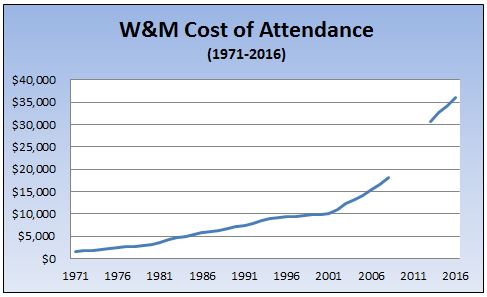by James A. Bacon
The General Assembly boosted state funding for higher education by $300 million in the upcoming two-year budget in the hope that public universities would restrain tuition increases. Most universities have complied. Even the University of Virginia dialed back its planned tuition hike from 3% to 1.4%. But the College of William & Mary has decided to take the money and run. An extra $3.8 million from the state is not enough to induce the university to back off its plan to jack up tuition 12% for the incoming freshman class this fall.
W&M’s defense, according to the Richmond Times-Dispatch: Technically, the tuition does not constitute an increase, for it applies to incoming undergraduate students only, and the university has pledged to freeze their payments for their four-year attendance at the college.
Maybe so, but tuition just keeps climbing, along with the overall cost of attendance, as can be seen in the graph above taken from online W&M data. (You might notice that four years of data are missing. That’s because W&M switched formats for reporting the cost of attendance, omitting the cost of room and board for four years, making it impossible for anyone drawing information from the Web to make a continuous, apples-to-apples comparison of the total cost of attendance.)
If the total cost of in-state attendance had marched in lockstep with the Consumer Price Index, it would be about $9,400 today. Instead, the actual cost will be an eyelash shy of $36,000 — four times higher.
The perennial excuse for higher tuition and fees is cuts in state funding. There’s just enough truth there to be semi-plausible. State support for William & Mary has rebounded in recent years but it is still lower than back in 2001. Here are the numbers for state support:
2000-2001 school year — $50 million
2012-2013 — $40.6 million
2013-2014 — $42.4 million
2014-2015 — 42.5 million
2015-2016 — $43.7 million
2016-2017 — $47.3 million
Adjusting for inflation, the General Assembly has fallen $20 million behind over 16 years. But consider: there are 6,300 undergraduates enrolled at W&M. At $36,000 a pop, increased tuition, fees and revenues (before adjusting for student aid) should bring in $227 million, an increase of about $189 million. Cuts in state support for higher education account for about 10% of that increase. Clearly, there are far more important factors at work, and just as clearly, those costs are out of control.
Del. S. Chris Jones, R-Suffolk, chair of the House Appropriations Committee, is not happy. “I’m extremely disappointed,” he told the T-D. “This is mind-numbing ad potentially shows the (college) board of visitors are out of touch with reality.”
Said Vice Chair R. Steven Landes, R-Augusta: “”They’re really making it tough for middle-income individuals and families to afford William & Mary.” The board’s decision, he said, is “outrageous.”
Bacon’s bottom line: William & Mary perceives itself as a “public ivy.” Its administration, faculty and board of visitors are all driven by a desire to maximize the prestige of the institution, which means enrolling students with higher SAT scores, recruiting more prestigious faculty, building a bigger endowment, and doing all the other things that win accolades in the U.S. News & World-Report top college rankings — even while competing against other prestigious institutions who also want to climb in the rankings. Meanwhile, the university is buckling under higher regulatory costs, with the federal government playing a more intrusive role than ever before, and it needs more money to pay for financial aid for poor and working class students.
Of all the competing goals that W&M would like to achieve, affordability for the middle class gets the short stick… which happens to be a top goal of General Assembly politicians catering to middle-class constituents. Tension is built into the state-university relationship.
Deep down inside, William & Mary wants to privatize, jack tuition and fees to the level the market will bear, recycle money back to the poor, and increase its standing and prestige compared to peer institutions. While I vacillate on the topic, I usually tend to the view that we should let W&M be W&M. Let the institution go private, end state support, and re-direct the $47 million a year to other public institutions.



